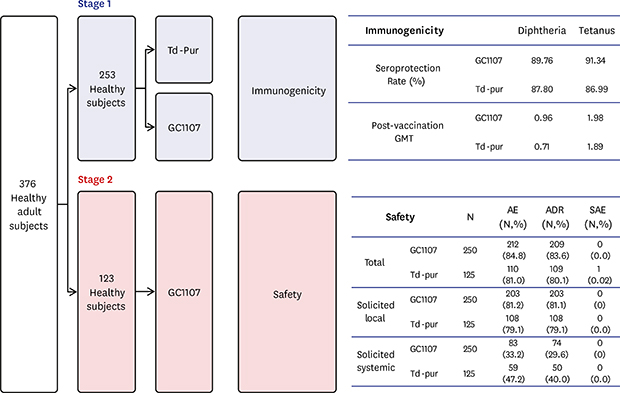1. Tiwari TS, Wharton M. Diphtheria toxoid. In : Plotkin SA, Orsentein WA, Offit PA, Edwards KM, editors. Plotkin's Vaccines. 7th ed. Philadelphia, PA: Elsevier;2018. p. 261–275.
2. Roper MH, Wassilak SG, Scobie HM, Ridpath AD, Orenstein WA. Tetanus toxoid. In : Plotkin SA, Orsentein WA, Offit PA, Edwards KM, editors. Plotkin's Vaccines. 7th ed. Philadelphia, PA: Elsevier;2018. p. 1052–1080.
3. Lee SY, Kim JS, Ahn JH, Choi JH, Ma SH, Park JS, et al. Immunoassay of diphtheria and tetanus according to ages. Infect Chemother. 2012; 44(2):62–66.

4. Hamborsky J, Kroeger A, Wolfe S. Epidemiology and Prevention of Vaccine-preventable Diseases. 13th ed. Washington, D.C.: Centers for Disease Control and Prevention;2015.
5. Hardy IR, Dittmann S, Sutter RW. Current situation and control strategies for resurgence of diphtheria in newly independent states of the former Soviet Union. Lancet. 1996; 347(9017):1739–1744.

6. Kang JH. The need of Td vaccination according to the changes of tetanus and diphtheria Immunity. J Korean Med Assoc. 2008; 51(2):127–136.

7. Kang JH, Hur JK, Kim JH, Lee KI, Park SE, Ma SH, et al. Age related seroepidemiological study of diphtheria among Koreans. Korean J Infect Dis. 2000; 32(1):1–7.
8. Kang JH, Hur JK, Kim JH, Lee KI, Park SE, Ma SH, et al. Age related serosurvey of immunity to tetanus in Korean populations. Korean J Infect Dis. 2001; 33(2):104–111.
9. Sung H, Jang MJ, Bae EY, Han SB, Kim JH, Kang JH, et al. Seroepidemiology of tetanus in Korean adults and adolescents in 2012. J Infect Chemother. 2014; 20(7):397–400.


10. Lee SY, Kwak GY, Mok HR, Kim JH, Hur JK, Lee KI, et al. The immunogenicity and reactogenicity of Td booster vaccination in Korean preadolescents, aged 11-12 years old. Korean J Pediatr. 2008; 51(11):1185–1190.
11. Lee SY, Kwak GY, Nam CH, Kim JH, Hur JK, Lee KY, et al. Immunogenicity and safety of diphtheria-tetanus vaccine in pre-adolescent and adolescent South Koreans. Vaccine. 2009; 27(24):3209–3212.


13. Choi JH, Kang JH. Tetanus, diphtheria, pertussis. In : Cheong HJ, Kim ES, Choi YH, Choi WS, Choi JH, Choi HJ, editors. Vaccination for Adult. 2nd ed. Seoul, Korea: MIP Press;2012. p. 189–204.
16. Lu PJ, O'Halloran A, Ding H, Liang JL, Williams WW. National and state-specific Td and TdaP vaccination of adult populations. Am J Prev Med. 2016; 50(5):616–626.


17. Kanitz EE, Wu LA, Giambi C, Strikas RA, Levy-Bruhl D, Stefanoff P, et al. Variation in adult vaccination policies across Europe: an overview from VENICE network on vaccine recommendations, funding and coverage. Vaccine. 2012; 30(35):5222–5228.










 PDF
PDF Citation
Citation Print
Print





 XML Download
XML Download